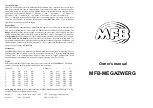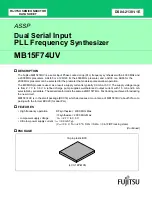
General
MEGAZWERG is a monophonic, semi-modular, analogue synthesizer. It can be used as an
autonomous synthesizer, as an expansion to our MFB-KRAFTZWERG or in combination with
any compatible modular synthesizer-system. It offers eleven sections that can be either used
for the internal sound-generating-system or separated to be integrated into the signal-path of
semi- or fully modular synthesizers.
A lot of important audio- and modulation-routings in MEGAZWERG are internally prewired,
so that the synthesizer can be played immediately using a MIDI-keyboard or a cv/gate-
sequencer. By using patch chords, you can split up these internal prewirings any time. All
MEGAZWERG functions not prewired can be integrated into the internal signal path or to
external components using patch chords.
Set-up and connections
Connect the external power-supply to the Power jack. Use VCA Out (in Loop-Envelope
section) to connect MEGAZWERG to a mixing desk, an audio-interface or an amplifier.
MEGAZWERG is controlled by MIDI or cv/gate. Use a MIDI-cable to connect MIDI In to
the MIDI-output of a keyboard or MIDI-interface. Alternatively, inputs CV In (Dual Glide or
VCO sections) and Gate In (Loop-Envelope section) can be connected to an analogue
sequencer or cv/gate-keyboard. Press On/Off to switch MEGAZWERG on and off.
Dual Glide
This section contains two independent slew limiters. These can be used to delay changes of
control voltages. A typical application would be the generation of portamento/glide-effects for
the oscillators’ pitch or the deformation of a LFO-square into a trapezoid waveform shape.
Slew1 offers larger delays and is only recommended to be used with control voltages, while
the shorter delay range of Slew2 makes it also applicable for audio signals.
Connect the cv-signal to be modified to input In1 or In2 and patch the outputs Out1 or Out2
to the target. Controls Slew1 or Slew2 set the amount of delay, with Slew1 being able to
create longer delay settings.
Internally, In1 is prewired to the pitch of the MIDI-input while Out1 is connected to the
oscillator’s cv-input, resulting in a portamento-effect. Input In2 is prewired to the cv-output of
the internal mod-sequencer (see below) to be able to smooth out its stepped values.
Modulation Sequencer
MEGAZWERG’s mod sequencer is a simple four-step-sequencer that can be externally
synchronized. When needed, the sequence length can be reduced to two or three steps using
the 2 – 3 switch. Rate sets the sequence-tempo/speed, ranging from approx. 0.1 Hz to 500 Hz.
Gate Out outputs a corresponding clock-gate-signal of 10 volts at the Rate setting. With the
Clock input being patched, the sequence-tempo/speed will follow incoming clock-signals.
This input can also be used to advance the sequence stepwise automatically by 5-volt-gate-
impulses. The sequence values are set by Step1 to Step4 controls. Depending on the position
of the Range switch, the step controls will output a maximum of 2, 5 or 10 volts. The
sequence is output at CV Out. CV Out is internally wired to input X-IN of the ring modulator
as well as to In2 of Slew2 to be able to smooth out the sequence’s stepped values. The
combination of mod sequencer and slew limiter forms a LFO with a free formable waveform
shape.
Oscillator/Ring modulator
The analogue, voltage-controlled oscillator is fixed to octave-register 16’. It can be tuned
within a range of approx. +/- 1 octave using the Tune control. It can be played by a cv-
keyboard scaled to 1 volt/octave using the CV input. CV is internally wired to Slew1 and
therefore also connected to inputs CV (key) and MIDI.
The VCO offers triangle, square and saw tooth waveform shapes, switchable by the upper
selector. The selected waveform is output to Out.
The ring modulator is an analogue circuit, building the sum and difference of two signals at
inputs X-In and Y-In. The resulting RM-signal is send to output Out. X-In and Y-In are
internally prewired to the outputs of the mod sequencer and the VCO. To use the ring
modulator with external audio signals, simply patch these to inputs X-In and Y-In.
Mixer
The mixer allows mixing of up to three audio- or cv-signals. Inputs In1 and In2 offer
attenuator controls, while input In3 always runs at full level. Internally, the VCO output is
wired to mixer-input In1 and the ring modulator to In2.The mixer’s output is prewired to the
filter’s audio input.
Multimode-Filter
MEGAZWERG offers a multimode-resonance-filter with a slope of 12 dB per octave. The
available modes are low-pass-, band-pass-, high-pass- and notch-filtering. LP-BP-NO-HP
selects between these modes. Note, although this is a continuous control, the filter modes are
switched NOT cross faded. Input In feeds audio into the filter. This input is internally
prewired to the mixer’s output. The filter’s output is available at output Out.
Cutoff allows manual setting of the filter’s cutoff frequency. This parameter can be modulated
using inputs CV-Cut and CV2 with corresponding attenuators.
CV-Cut is internally wired to
the envelope section as well as to CV2 combined with key-cv from the MIDI-input.
The filter resonance is set manually using the Resonance control. Modulation of this
parameter is possible through input CV-Reso with the corresponding attenuator. Resonance
can reach self-oscillation.
Loop-Envelope/VCA
MEGAZWERG’s envelope section consists of five stages Attack, Hold, Decay, Sustain and
Release, all offering individual controls. In addition, stages 1 to 3 can be looped. The Loop
switch enables/disables the loop-function. If enabled, the loop is carried out as long as there is
an active gate signal. The envelope receives its gate-triggers from input Gate or any incoming
MIDI-note-command.
The VCA controls MEGAZWERG’s audio output which is under cv-control only. Input VCA
In is internally connected to the filter’s output. Control input CV In is internally patched to
the gate-signal created by incoming MIDI-note-commands. It uses a minimal release time to
avoid clicks at the end of sounding notes.




















